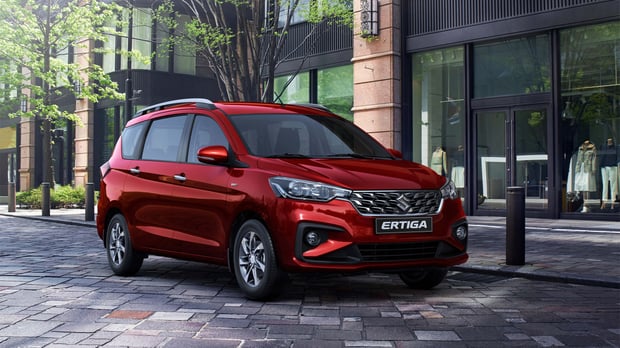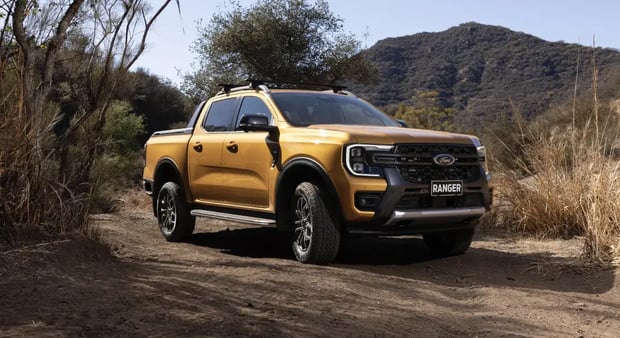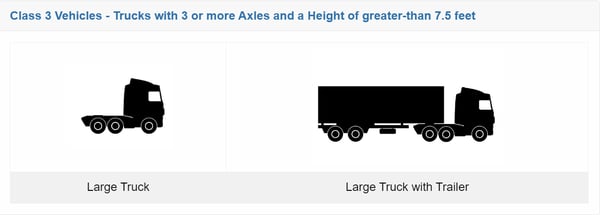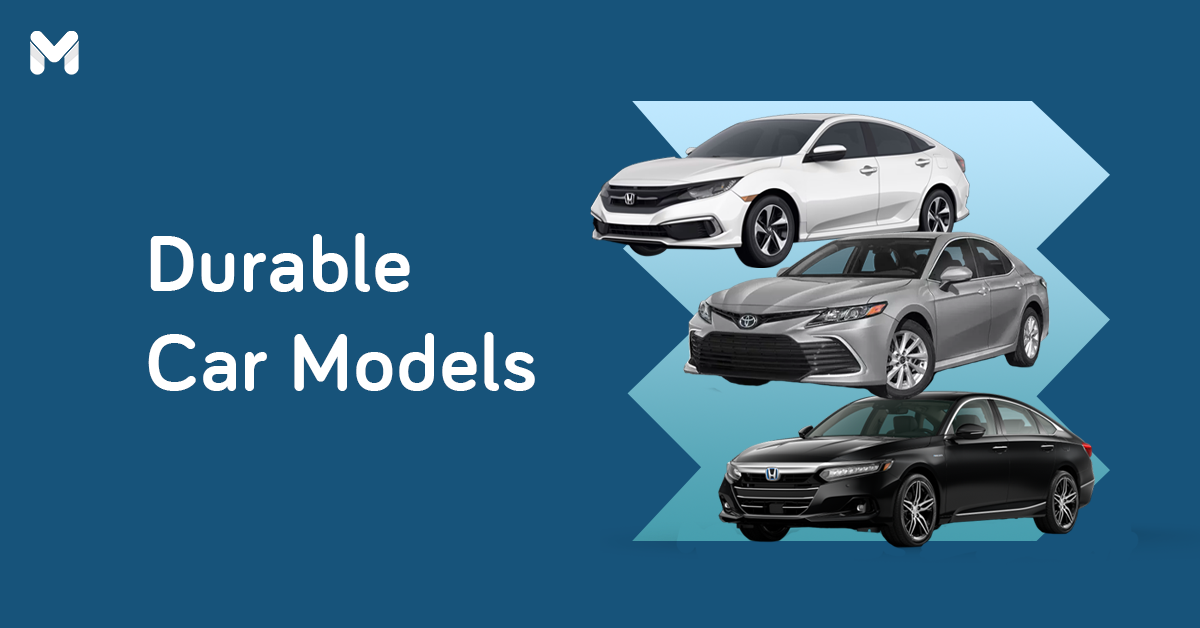For most of us, a car is simply an item of pure utility. Its only job is to take you from point A to point B—the kind of car you’re driving shouldn’t be a big deal.
But not all cars are created equal. While they have the same purpose, they may differ in engine, power, and other specs.
Should vehicle classifications in the Philippines matter? The practical answer is yes. The type of car you’re planning to own will affect subsequent expenses, such as toll fees, insurance, and upkeep.
Moreover, you need a car that suits your lifestyle. For instance, you don’t want to get a hatchback if you have a family of six.
To help you pinpoint the kind of car you need, read this simple guide to different types of vehicles in the Philippines.
10 Vehicle Classifications in the Philippines Based on Body Type
The size and outline of a car can give you an idea of its classification. Here are the most popular options in the country:
🚗 Hatchback

Hatchbacks used to be boxy and boring. But they’ve undergone modifications over the years, now sporting smoother lines and a more elegant look.
A hatchback is a small car with a tailgate or rear door you can open upward. It’s usually cheaper than cars under other vehicle classifications in the Philippines, so it appeals to many first-time owners.
Its size is perfect for city driving—you can easily navigate streets and alleys. It's also just the car if you have a small parking area at home. Plus, even with its size, it can accommodate up to five passengers, including the driver.
Popular hatchbacks include Toyota Wigo, Suzuki S-Presso, Suzuki Swift, Kia Picanto, Honda Brio, and Mitsubishi Mirage.
🚗 Sedan

A sedan is a very straightforward car. This car has four doors and a trunk separated from the passenger compartment. To accommodate longer objects, open a pass-through by folding the rear seatback.
A sedan is often a flagship model for many car makers. With its simplicity and versatility, it’s a popular option among families, business owners operating a TNVS (e.g., GrabCar), and companies with a car fleet. Base models are generally affordable, so it's a good option for first-time car owners, too.
Toyota Vios, Nissan Almera, Honda City, and Hyundai Accent are among the most popular sedans in the Philippines.
🚗 Coupe

A coupe looks very much like a sedan, but there are a few key differences between these two types of vehicles. For one, a coupe has two doors while a sedan has four.
A sedan usually follows a wholesome style. A coupe, on the other hand, sports an athletic look, integrating smoother and more aerodynamic lines.
A coupe is more driver-centric, as it usually seats up to two people only. The rear seats, if any, are smaller.
With its powerful engine and lighter build, this vehicle type boasts a sporty performance. That said, you may need to shell out a considerable amount of cash, as coupes are typically expensive.
A lot of sports cars are coupes. Popular ones include the Ford Mustang, Chevrolet Camaro, Chevrolet Corvette Stingray, and Toyota 86.
🚗 Convertible

Also known as a roadster, a convertible follows the coupe's build in that it has two doors and an athletic look. It's also light and boasts smooth handling.
But the difference between a coupe and a convertible is that the latter’s roof can be retracted. Drivers can hit the road in the open air.
Is it too sunny or is it about to rain? Just put the roof back up via a manual or motorized mechanism.
Ferrari is known for its convertibles. If you’re looking for alternatives, consider the Ford Mustang, Mazda MX-5, Mercedez-Benz SL-Class, and BMW Z4.
🚗 Sports Utility Vehicle (SUV)

A sports utility vehicle or SUV is a large vehicle with specifications and features borrowed from light trucks. It follows a two-box design, meaning the engine compartment and passenger cabin are two separate spaces. It usually has three rows of seats to accommodate up to seven people.
An SUV's engine and drive configuration are built for a variety of surfaces, from smooth city streets to uneven dirt roads. Such a setup offers the toughness and flexibility many weekend warriors and road trip lovers look for. Nevertheless, an SUV also makes a good family car.
When it comes to exteriors, most SUVs don a bold look. Their size gives them an imposing appearance on the road. Because of their luxurious appeal and hefty price tag, they’re usually considered a status symbol.
Some of the best SUVs in the Philippines include Toyota Fortuner, Mitsubishi Montero Sport, Nissan Terra, Chevrolet Trailblazer, and Isuzu mu-X.
🚗 Multi-Purpose Vehicle (MPV)

If an SUV is too pricey or big for you, a good alternative is a multi-purpose vehicle or MPV. An MPV looks smaller than an SUV, but still offers a generous space that can accommodate up to seven people. While SUVs have a commanding and tough appearance, MPVs sport tamer lines and curves, rendering them wholesome and approachable.
Typically, an MPV has three rows of seats. The rear seat can be folded to offer space for the cargo. With its size and practicality, an MPV makes an ideal family car.
Popular options for the best MPV cars in the Philippines are the Toyota Innova, Toyota Avanza, Toyota Rush, Suzuki Ertiga, Suzuki APV, and Mitsubishi Xpander.
🚗 Asian Utility Vehicle (AUV)
Also known as basic utility vehicles, Asian utility vehicles or AUVs are a car type manufactured for developing countries, such as the Philippines. These haulers can transport both people and cargo.
The AUV’s styling differentiates from SUVs and MPVs in that AUVs have a smooth front and a semi-boxy cabin. Somehow, their overall design is reminiscent of small jeepneys. Nevertheless, AUVs have seen modern modifications over the years, giving them refreshed aesthetics and a renewed reputation.
AUVs are a well-loved vehicle classification in the Philippines because of their versatility. They can be either used as a family car or a shuttle service (e.g., UV Express vehicles).
Popular models include the Toyota Tamaraw FX, Toyota Revo, Mitsubishi Adventure, and Isuzu Crosswind. While a lot of car manufacturers have already discontinued their AUV lines, you can still find some in secondhand markets.
Related articles:
- Is It Better to Buy a Brand-New or Second-Hand Car in 2024?
- Best Tips for Buying a Used Car in the Philippines
🚗 Crossover

Crossovers are essentially utility vehicles with some features borrowed from SUVs, hence the classification name. Like SUVs, crossovers can take on different road conditions, from smooth urban thoroughfares to rugged provincial roads. Moreover, their distinguished aesthetics are heavily inspired by SUVs.
However, unlike an SUV, this vehicle classification in the Philippines uses a unibody structure. This means the crossover’s body and frame form a single structure. An SUV, on the other hand, is built by attaching the chassis to the car’s body.
Size is also a defining factor. A crossover is smaller and more compact than an SUV. It also has a lower ground clearance compared to that of its big brother.
Kia Stonic and Mazda CX-30 are some examples of a crossover.
🚗 Pick-Up Truck

Originally designed as an all-around workhorse, the pick-up truck is now a lifestyle vehicle that offers a lot of versatility.
With a large cargo bed and powerful off-road capabilities, pick-up trucks are well-liked by people who take long road trips or run a business. The cargo bed is often left uncovered, so it can accommodate larger and taller loads. Design-wise, pick-up trucks usually appeal to those who favor ruggedness over elegance.
Popular models of this vehicle classification in the Philippines include the Ford Ranger, Ford Ranger Raptor, Toyota Hilux, Nissan Navara, and Mitsubishi Strada.
🚗 Van

Many look at vans as large moving boxes. But their no-nonsense practicality is the secret behind their staying power in the automotive industry.
First, they're more spacious than most cars. They can accommodate up to 18 people, depending on the seat configuration. They also have a high headroom, which makes it easier to load taller cargo.
Toyota Hiace, Nissan Urvan, and Hyundai Grand Starex are some of the most popular vans in the Philippines.
If you’re gunning for additional comfort and luxury, consider a minivan. However, note that it’s generally more expensive compared to a full-sized van. Toyota Alphard, Kia Grand Carnival, and Chrysler Town & Country are among the most sought-after minivans out there.
LTO Vehicle Classifications in the Philippines for Car Registration
Meanwhile, for registration purposes, the Land Transportation Office (LTO) classifies vehicles into the following:[1]
- Passenger cars
- Light
- Medium
- Heavy)
- Utility vehicles
- Up to 2,700 kg
- 2,701 to 4,500 kg
- Sports utility vehicles
- Up to 2,700 kg
- 2,701 to 4,500 kg
- Trucks and truck buses
- 4,501 kg and above
- Trailers
- Less than 0.75 tonnes
- Over 0.75 tonnes but less than 3.5 tonnes
- Over 3.5 tonnes but less than 10 tonnes
- Over 10 tonnes
- Motorcycles
- With sidecar
- Without sidecar
The Motor Vehicle User's Charge (MVUC), commonly known as the road user tax, differs per vehicle type.
Car Classifications in the Philippines Based on Vehicle Size and Weight
On the other hand, The Toll Regulatory Board (TRB) has its own system of motor vehicle classification in the Philippines.[2] The said agency categorizes vehicles based on their number of axles and height. Your toll fees will depend on your vehicle type as classified by the TRB.
📌 Class 1 Vehicles

This vehicle classification includes those with two axles and an overall height of up to 7.5 feet. Examples include passenger cars, vans, jeepneys, pick-up trucks, and motorcycles with a 400cc engine and above.
📌 Class 2 Vehicles

Vehicles with two axles and a height of more than 7.5 feet under this classification. These include buses and trucks.
📌 Class 3 Vehicles

This heavy vehicle classification in the Philippines covers trucks with three or more axles and a height greater than 7.5 feet. These include large trucks and large trucks with trailers.
Final Thoughts
Cars come in different shapes and sizes, which can make it challenging to choose one. To make this task easier, look at your lifestyle and financial capabilities. Pick the right vehicle classification in the Philippines so you can properly maximize your car.
If you’re still confused or overwhelmed, don’t hesitate to seek the help of a friend who owns a car. In case you already have a particular model in mind, do your due diligence by probing the sales agent and test-driving the car to your heart’s content.
🛡️ Get a Free Car Insurance Quote Online
Protect your upcoming investment with a car insurance policy that suits your needs and budget. Check out these options from top providers in the Philippines. Get a free quote from Moneymax now—it's just a few clicks away!
| Car Insurance Company | Maximum Total Sum Insured | CTPL Coverage | Own Damage & Theft Coverage | Acts of Nature Coverage | Death / Disablement Coverage |
|
FPG Insurance
|
₱4 million
|
✔️
|
✔️
|
✔️
|
|
|
Malayan Insurance
|
₱7.5 million
|
✔️
|
✔️
|
✔️
|
|
|
The Mercantile Insurance Corporation
|
₱5 million
|
✔️
|
✔️
|
||
|
OONA Insurance (formerly MAPFRE)
 |
₱5 million
|
✔️
|
✔️
|
✔️
|
✔️
|
|
PGA Insurance
 |
₱3 million
|
✔️
|
|||
|
SGI Philippines
|
₱5 million
|
✔️
|
✔️
|
✔️
|
|
|
Standard Insurance
|
₱5 million
|
✔️
|
✔️
|
✔️
|
✔️
|
|
Stronghold Insurance
|
₱3 million
|
✔️
|
Sources:
- [1] Motor Vehicle Registration (LTO)
- [2] Vehicle Classifications (TRB)







_1200x350.png?width=751&height=219&name=UB_PL_Generic_2_(Jan_2025)_1200x350.png)
_1200x350.png?width=751&height=219&name=UNOBank_Loan_Generic_Ad_(Apr_2024)_1200x350.png)


